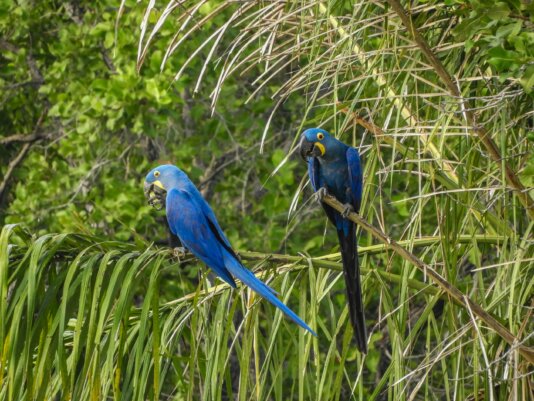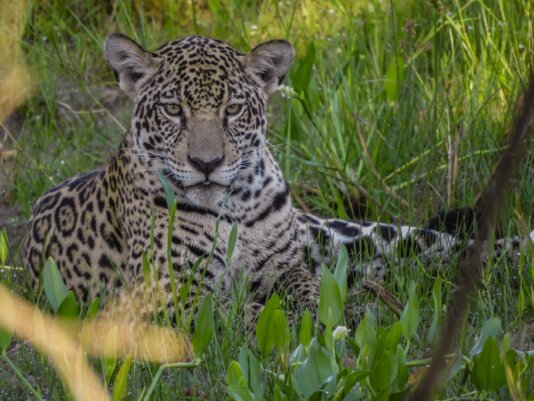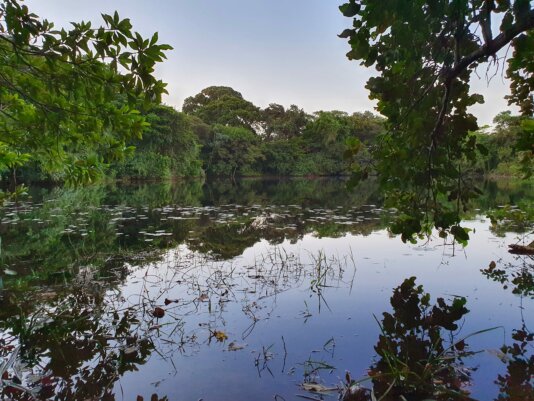- About
- Topics
- Picks
- Audio
- Story
- In-Depth
- Opinion
- News
- Donate
- Signup for our newsletterOur Editors' Best Picks.Send
Read, Debate: Engage.
| May 06, 2021 | |
|---|---|
| topic: | Conservation |
| tags: | #Pantanal, #wetlands, #jaguars, #wildfire, #climate crisis, #safari |
| located: | Brazil |
| by: | Ellen Nemitz |
FairPlanet has attended one of these safaris. While the car drove through the roads of Caiman Ecological Refuge where Onçafari is based, green areas were full, there was a variety of birds beginning their daily feeding journey, as well as other little mammals, alligators and all the biodiverse fauna of Pantanal. Most of these populations are balanced and healthy due to the jaguars at the top of the food chain.
Around an hour later, the radio gave the signal: Pirilampa, a female jaguar wearing a GPS collar, was in the area.
The collar is put in some animals in order to monitor their movements and habits; it does not hurt, is very light and gives the researchers priceless information, such as if the animal is healthy, chasing and procreating. “The collar also saves lives, because a farmer will not shoot a monitored jaguar dead, as he knows there is a GPS on it and authorities will be notified,” explains Lili Rampim, coordinator of Onçafari.
At night we’d reached another safari in which the biologists identified the signal of Fera and found her during chasing time. Getting so close to the jaguars is possible nowadays because of the habituation work; that is, they do not fear the car anymore (this is important for research and ecotourism and, thus, for conservation).
Fera is, by the way, an icon of the project. She and her sister, Isa, became orphans after their mother accidentally died when receiving an overdose of tranquilizer. The two would be condemned to living in a zoo; in nature, mothers teach their cubs how to chase and live as a jaguar. Onçafari took on the role and step by step, in a controlled area, led them while discovering their instincts.
Released back into the wild in 2016, Fera and Isa are now grandmothers and show the success of the reintroduction project. This case gives hope to the species, especially in Pantanal and the Amazon, where populations are stronger. Jaguars are already extinct in Pampa, a biome in south Brazil, and populations are not sustainable in others. In the Atlantic Forest, for instance, endogamy is common and they may be extinct in 20 years if nothing is done.
Part of the Onçafari staff witnessed the fires that decimated 60 percent of the Caiman property in 2019. They remember the despair of trying to save people, houses, trees and animals. Some species are now more difficult to see - some monkeys, for example - the field biologist said. Except for this fact and some carbonised tree trunks (the trees are already green again), nothing indicates that such a huge fire took place just 18 months ago. From trees to animals, nature is thriving once again.
Nonetheless, there are impacts that go beyond our eyes, and universities, public research agencies and NGOs are working to better understand them; most of the findings are coming up. WWF-Brazil brings good news, however: the hyacinth macaw, an endangered species whose nets were affected by the fires, survived with the help of projects like the Hyacinth Macaw Institute.
However, in an interconnected ecosystem such as Pantanal, which constitutes the biggest wetland in the world, each creature has a role - even small insects and microorganisms - and preventing new fires from getting out of control is vital for the long-term survival of the biome.
The fires of 2020 affected a large area, mostly in north Pantanal, in the state of Mato Grosso. During the dry season, fires spread easily and, although there are natural causes such as lightning, their main source of ignition is human activity.
Climate change is also a risk factor, as dry seasons are getting longer and rain levels, even during months when the water rises, are lower. According to a report from WWF, in 2019 it rained 25 percent less than average; one year later, the situation was worse, with a 40 percent drop.
Despite all adversities, this region of Caiman showed that preventing fires (or at least limiting their spread) is possible when efforts are gathered and the investments are made in the right tools. It is easy to see, in different places of the property, water reservoirs that would work to prevent fires from passing as well as provide water to firefighters. Besides, they created a net of neighbours counting on satellite maps: if a fire spot is detected in one of the partner properties, the owner is alerted and resources are sent to that area to help.
All these strategies are valuable. However, people in this region of Pantanal are also investing in a long-term solution: education. The activity of livestock production is traditional in Pantanal. As agriculture isn’t viable due to annual floods, cattle is part of Pantaneiros culture and follows sustainable methods in most cases.
The use of fire to burn the pasture is one of the best ways of making graze regrow more nutritious and attractive to the animals; doing it under the right conditions and in the right time, before a severe drought hits, can largely reduce the risk of uncontrolled fires. “We do not want to abolish the cattle from Pantanal. It will remain here, but we need to find a way of walking hand to hand, livestock and conservation,” Lili affirms.
This partnership is beneficial both for nature and the communities. Once jaguars are alive and easier to be seen, more tourists come to Pantanal (before the Covid-19 pandemic the majority of visitors were foreign and now Brazilians are discovering it) and the profits of this activity attract even the more skeptic farmers.
It is also life changing: several men born and raised in Pantanal find in tourism a way of earning a living and also connecting with the exuberant nature of their homelands. Meanwhile, women who would otherwise remain at home find a purpose in a paid job and children grow up with better perspectives.
Pantanal is a very singular region, with two well defined seasons: the flood happens between November and April, when the rainfalls drain to the prairie. The other six months are dry, and the water remains just in a few areas; this cycle, as mentioned before, is changing as the climate changes.
As another dry season is coming up in Pantanal, the risk of another huge fire arises.
The NGO SOS Pantanal has made a long journey through the farms and reserves helping to prepare them for possible fires. However, a group of research institutes, universities and civil society organisations alerted authorities that there are necessary measures to be implemented now if we want to prevent another tragedy.
In a letter written to Congress, they list some of the urgent actions: creating and maintaining fire brigades, purchasing adequate equipment, launching information campaigns among local communities and identifying the people responsible for starting uncontrolled fires. They also mention the importance of stopping the construction of a new hydroelectric power plant in the Hydrographic Region of Paraguay, the effective use of Army Forces to control fires and the needed investments in research.
An article titled A desoladora herança dos incêndios (‘The desolator heritage of fires’), published in the Ciência Pantanal Magazine, explains that fires - natural or human-induced - are part of Pantanal history. However, mistakes and wrong interventions made them spiral out of control in 2019 and 2020.
“Pantanal has been through longer drought periods, such as the 14 continuous years of drought between 1960 and 1974, when the fires also devastated vegetation and native pastures,” the authors recall. On that occasion, they say, Pantanal recovered by itself and the memory of the crisis remained for decades, helping to prevent similar occurrences. That had been the case until 2020, when it seemed to have been forgotten.
From now on, the path to prevent catastrophes is, according to WWF, combining traditional and scientific knowledge in addition to modern techniques and resources. “Prevention is the best choice, always. And it is within reach of the human population.”
Image: Ellen Nemitz.
By copying the embed code below, you agree to adhere to our republishing guidelines.



